+ JMJ +
Giorgio Morandi (Italian, 1890–1964)
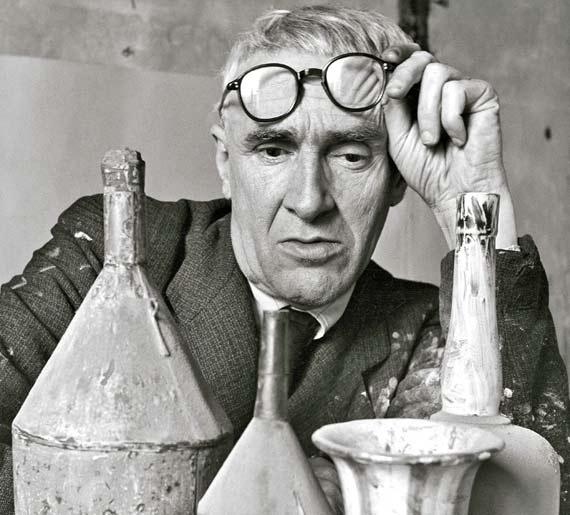
Photograph of Morandi in his studio in 1953
By Herbert List
[Source]

Still Life, 1916
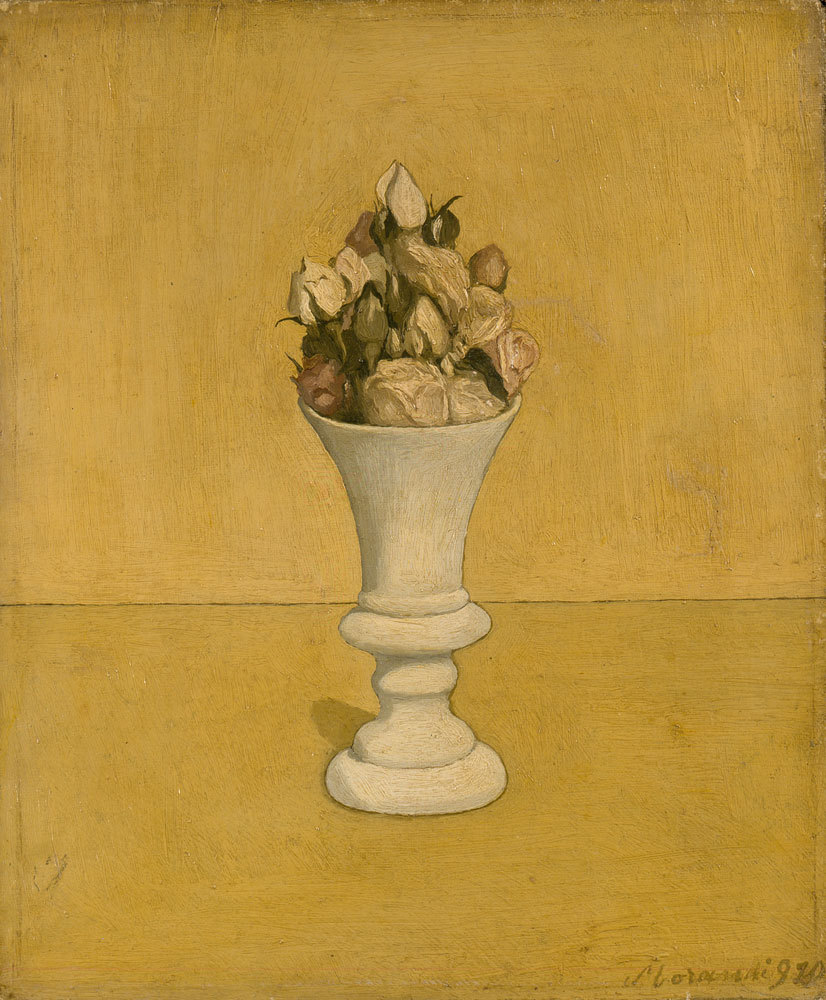
Morandi first exhibited his work in 1914 in Bologna with the Futurist painters, and in 1918–19, he was associated with the Metaphysical school, a group that painted in a style developed by Giorgio de Chirico and Carlo Carrà. Artists, who worked in the Metaphysical painting style, attempted to imbue everyday objects with a dreamlike atmosphere of mystery. [Source]

Morandi developed an intimate approach to art that,
directed by a highly refined formal sensibility, gave his quiet
landscapes and disarmingly simple still-life compositions a delicacy of
tone and extraordinary subtlety of design. [Source]

Still Life, 1938
Still Life, 1949

He taught drawing and printmaking for decades, first in elementary schools, then at the city’s art academy. He had many friends among Bolognese artists and intellectuals, who acknowledged and extolled his work. Like many artists in Italy before World War II, he had passive brushes with Fascist politics, though the degree of his commitment remains a matter of conjecture. What is not in doubt is his single-minded devotion to his work, and the path he traveled to develop it. [Source]




Still Life1955

Still Life1955
Oil on canvas

Photograph of Morandi in his studio in 1953
By Herbert List
[Source]
Giorgio Morandi is one of my favorite artists! I discovered his work while I was studying Painting and Drawing in Florence, Italy in the mid-80's. Here are some of his marvelous paintings.

Still Life, 1916
Oil on canvas
Giorgio Morandi
Museum of Modern Art, New York
[Source]Museum of Modern Art, New York
Morandi’s still lifes are beautiful, they are so evidently shaped by self-restraint. Taken one by one, the paintings are close studies in rhythm and balance. [Source]

Flowers (Fiori), 1920
Oil on Canvas
Oil on Canvas
Giorgio Morandi
[Source]
It is possible to think of (his) still
lifes ... as a meditation on time, art, isolation, self-preservation and
the ordinary mystery of all of that. [Source]
Morandi first exhibited his work in 1914 in Bologna with the Futurist painters, and in 1918–19, he was associated with the Metaphysical school, a group that painted in a style developed by Giorgio de Chirico and Carlo Carrà. Artists, who worked in the Metaphysical painting style, attempted to imbue everyday objects with a dreamlike atmosphere of mystery. [Source]

Still Life, 1938
Oil on canvas
Giorgio Morandi
Claudia Gian Ferrari Collection
Claudia Gian Ferrari Collection

Still Life, 1938
Oil on canvas
Giorgio Morandi
Museum of Modern Art, New York
Museum of Modern Art, New York
[Source]
His gentle, lyrical colours are subdued and limited to clay-toned whites, drab greens, and umber browns, with occasional highlights of terra-cotta. [Source]

The White Road, 1939
(La Strada Bianca)

Still Life, 1943

Still Life, 1943

Still Life, 1947

Still Life1947 - 1948



His gentle, lyrical colours are subdued and limited to clay-toned whites, drab greens, and umber browns, with occasional highlights of terra-cotta. [Source]

The White Road, 1939
(La Strada Bianca)
Oil on canvas
Giorgio Morandi
Private Collection
[Source] Private Collection
Morandi’s paintings of bottles and jars convey a mood of contemplative repose reminiscent of the work of Piero della Francesca, an Italian Renaissance artist whom he admired. [Source]

Still Life, 1943
Oil on canvas
Giorgio Morandi
[Source]
Still Life, 1943
Oil on canvas
Giorgio Morandi
Hirshhorn Museum of Sculpture Garden
Washington, DC
[Source]
Morandi comes with his own personal mystery, or myth, depending on
what you hear. There seem to be two stories, the first of which — the
life of St. Giorgio the Hermit — is the more popular. [Source]

Still Life, 1947
Oil on canvas
Giorgio Morandi
Art Gallery of New South Wales
Sydney, Australia
[Source]Art Gallery of New South Wales
Sydney, Australia

Still Life1947 - 1948
Oil on Canvas
Giorgio Morandi
[Source]
It is the
tale of a deeply reclusive Italian artist who lives his whole life in a
single apartment, from which he rarely goes far. Though he teaches
printmaking in the local art school, he sees almost no one socially. He
rarely travels, is unaware of public events around him, knows little of
new art elsewhere. Despite scant recognition of his art, he doggedly
paints away in a tiny at-home studio to the end of his days. [Source]


Still Life1948 - 1949
Oil on canvas
Oil on canvas
Giorgio Morandi
[Source]

Still Life, 1948 - 1949
Oil on canvas
Giorgio Morandi
[Source]
Then there is a second story. In this one a shy but cosmopolitan painter
socializes regularly with fellow artists and keeps up, through books
and magazines, with art developments in the larger world. He travels
extensively within his homeland and is alert to events, political and
otherwise, there. His work attracts an international following.
Genuinely retiring by nature, he uses his reputation as a recluse to
pick and choose his company and to reserve his energies for art. [Source]

Still Life, 1949
Oil on canvas
Giorgio Morandi
Art Gallery of New South Wales
Sydney, Australia
Art Gallery of New South Wales
Sydney, Australia
[Source]
Details from both stories dovetail in the life of the real Morandi. He
was born in Bologna, in northern Italy, into bourgeois comfort. He
studied art in the city and never moved from his family’s apartment,
which he shared with three unmarried sisters. There he had a small
bedroom, and adjoining it, an even smaller studio. [Source]

Still Life, 1949
Oil on canvas
Giorgio Morandi
Museum of Modern Art, New York
[Source]Museum of Modern Art, New York

He taught drawing and printmaking for decades, first in elementary schools, then at the city’s art academy. He had many friends among Bolognese artists and intellectuals, who acknowledged and extolled his work. Like many artists in Italy before World War II, he had passive brushes with Fascist politics, though the degree of his commitment remains a matter of conjecture. What is not in doubt is his single-minded devotion to his work, and the path he traveled to develop it. [Source]

Still Life1951

Still Life, 1951
Oil on Canvas
Oil on Canvas
Giorgio Morandi
Museo Morandi, Bologna, Italy
[Source]
From his student
years he knew and revered the art of Cézanne; the earliest paintings at
the Met attest to this. From 1913 comes a Mont Sainte-Victoire-ish
landscape done at his family’s summer home; and from two years later, a
variation on Cézanne’s “Five Bathers,” but with nudes that look as
boneless, slippery, and compressed as sardines packed in oil.
Thereafter, apart from a few youthful self-portraits — two are in the
show — Morandi avoided the human figure. [Source]

Still Life1952
Oil on canvas
Giorgio Morandi
San Francisco Museum of Modern Art
San Francisco Museum of Modern Art
Yet he was looking at
lots of figures, all the time. In 1910 he made his first trip to
Florence and saw Giotto’s paintings, with their firm, blocklike,
feet-on-the-ground bodies anchored in space. In Rome came another
revelation: the fleshly miracles of Caravaggio.
And at some point, somewhere, possibly in Urbino, he began a long
relationship with the sun-bleached bodies and buildings of Piero della
Francesca. [Source]


Still Life1953
Oil on canvas
[Source]
From all of these artists, Morandi learned something. From Giotto
and Caravaggio he learned how to create weight in painting. From Piero
he learned about light and its drama. From Cézanne he took two things.
One was the idea of nature as personal artifice, something you observed
but then made up. The other was a piece of cautionary advice: “The
grandiose grows tiresome.” [Source]

Still Life1955
Oil on canvas
Giorgio Morandi
[Source]

Morandi is never grandiose, though he can be grand. And despite his
repetition of themes, he is never wearing. I found myself waking up
rather than winding down as I walked through the show. [Source]

Still Lifec. 1955
Oil on canvas
Giorgio Morandi
[Source]
Still Life1955
Oil on canvas
Giorgio Morandi
National Gallery of Art, Washington, DC
[Source]National Gallery of Art, Washington, DC
He also included Corot and Chardin in this aesthetic start-up kit.
And he took careful notice of his contemporaries. He checked out the
Futurists. After meeting Carlo Carrà and Giorgio di Chirico, he briefly
aligned himself with the movement or style called Pittura Metafisica, to
which he contributed a few immaculately spacy still lifes. [Source]

Still Life, 1956
Oil on Canvas
Oil on Canvas
Giorgio Morandi
Yale University Art Gallery
Still Life, 1956
Oil on canvas
Giorgio Morandi
[Source]
But metaphysics, to the extent that it involved a belief or a program, was never of interest to him in art. And in the 1920s he moved on to painterly realism. The two self-portraits — virtually identical, expressionless, slightly hangdog — date from this time, as do landscapes dominated by houses with Piero-style light-washed walls. [Source]

Still Life, 1956
Oil on canvas
Giorgio Morandi
[Sold for $1.2 million at Bologna’s Galleria d’Arte Maggiore.]
[Source][Sold for $1.2 million at Bologna’s Galleria d’Arte Maggiore.]
And the production of still lifes began in earnest, the first of
which were thickly brushed and densely populated tableaus. Filled to the
edges with bristling forms — skinny bottles, pots with sticking-out
handles — they are done in nougat beiges and chocolate browns, bread and
earth colors, interrupted by patches of mineral-red and cobalt blue. [Source]

Still Life1957
Oil on canvas
Giorgio Morandi
Art Gallery of New South Wales
Sydney, Australia
Sydney, Australia
[Source]
His repertory of studio props, salvaged from the family kitchen or
bought secondhand, was more or less in place. It encompassed carafes of
various sizes, jars, teapots, Ovaltine boxes and vases, with and without
flowers. Some of these containers he customized, touched up with paint
or covered with paper, to make them look generic, to call attention to
their shape and mass. [Source]


Still Life1957
Oil on canvas
Giorgio Morandi
Princeton university Art Museum
[Source]

Still Life1957
Oil on canvas
Giorgio Morandi
Musée Jenisch, Vevey, Switzerland
Musée Jenisch, Vevey, Switzerland
Certain items came and went. Strange clocks were prominent for a
while, then disappeared. In the early 1940s there was a sudden infusion
of seashells. With their irregular shapes, spectral colors and
dangerous-looking protrusions, they introduced a disturbing, aggressive
organism into Morandi’s pictorial world. It is surely no coincidence
that the shells appear in paintings done at a time in World War II when
Bologna was being bombed. [Source]
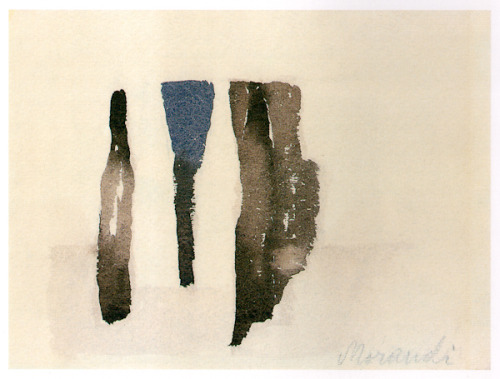
But Morandi’s still lifes from all periods can be visually unsettled
and psychologically fraught. In a series from 1941, arrangements of
bottles and vases, painted in tones of white and light gray and arrayed
processionally across the canvas, suggest the serene, if icy, facade of a
Doric temple, but with columns so closely placed as to prevent
admission. [Source]

Still Life1961
Oil on canvas
Giorgio Morandi
Museo Morandi, Bologna, Italy
Museo Morandi, Bologna, Italy
[Source]
Later, in the 1950s, objects grow fewer and smaller in scale and
tend to be centrally placed in stretches of empty space, an effect a
little reminiscent of abstract, “cosmic” Wagner productions of the time.
In some cases we view the arrangements at eye level, but more often
from slightly above. From this commanding God’s-eye perspective, the
objects look slight, squat and vulnerable, like figures awkwardly
pressing together for a snapshot, or huddling under a searchlight. [Source]

In
Morandi's still-life paintings, the artist used the same objects
repeatedly; the subject was secondary to the manner of representation.
After 1950, his style became increasingly abstract. In this painting,
the objects are grouped together in the centre of the composition, as if
in self-protection, and are painted with a nervous, quivering line.
Morandi is dealing primarily with shape, space and colour, and seems to
avoid all hint of symbolism or narrative. However, his choice of subject
matter and manner of presentation suggest qualities of modesty,
reflection and silence. [Source]
![Natura Morta [Still Life]](http://www.nationalgalleries.org/media/38/collection/GMA%20906.jpg)
Still Life1962
Oil on canvas
Giorgio Morandi
National Galleries Scotland
National Galleries Scotland
[Source]
Although Morandi rejected the idea of abstraction in his art, that
was the direction it was heading. The last oil-on-canvas still lifes are
basically composed of blocks and cylinders — are these containers? what
could they contain? — and snarled-up biomorphic forms merging into
other forms. And in watercolor painting, which became his late preferred
medium, solids become mere stains soaked into atmosphere. [Source]

Landscape, 1962
Oil on canvas
Giorgio Morandi
Museo Morandi, Bologna, Italy
[Source]
By then, Morandi had achieved international fame, both for his
paintings and for his extraordinary prints, which are too little sampled
in the show, organized by the Met and the Museo d’Arte Moderna of
Bologna, with Maria Cristina Bandera, director of the Roberto Longhi
Foundation in Florence, and Renato Miracco, director of the Italian
Cultural Institute in New York, as curators. [Source]

You might ask other artist-poets this question: Joseph Albers, say, or Paul Klee or Agnes Martin or a New York artist I know who sits down at his apartment desk for two hours every day — only two, but always two — to embroider small squares of raw canvas with abstract patterns in silk thread. The work is close, slow and painstaking, done stitch by stitch, row by row — letter by letter, line by line — in calligraphic loops and tufts. An inch of embroidery, approximately the size of a sonnet quatrain, takes months to complete. [Source]
His hand had lost steadiness; his eyesight was, perhaps, failing. But he didn’t rest. He kept painting. Why? [Source]
... the work goes on. Because it is controllable reality. It is a
form of thinking that frees up thought. It is time-consuming, but
time-slowing, isolating but self-fulfilling. It is a part of life, but
also a metaphor for how life should be: with everything in place, every
pattern clear, every rhyme exact, every goal near. [Source]
(Text excerpts from New York Times article written by Holland Cotter.)

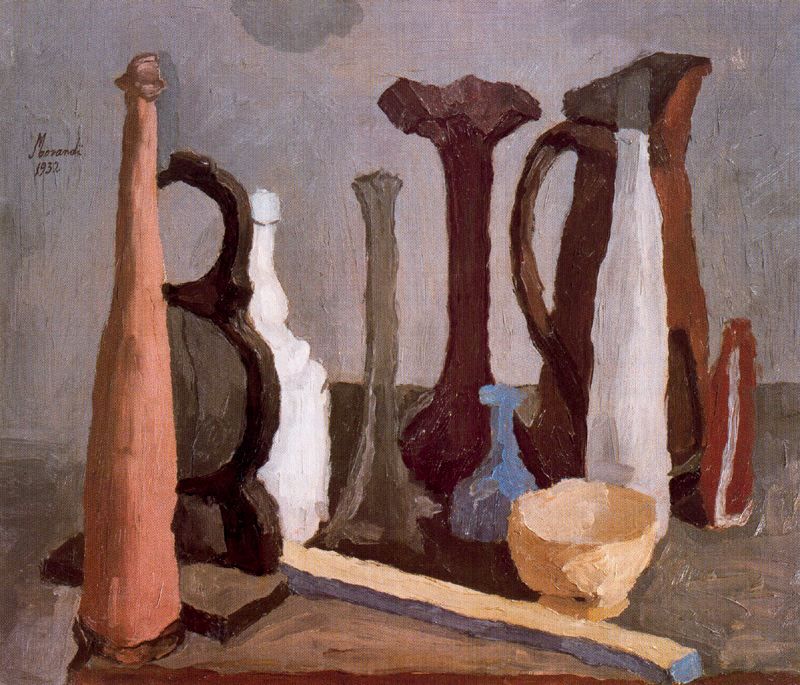
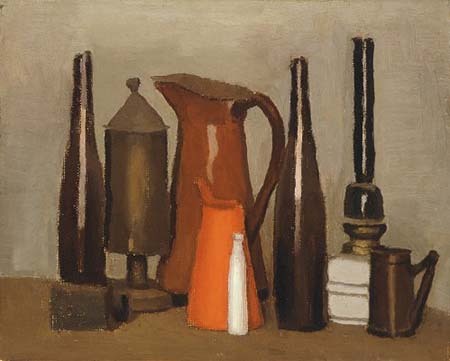


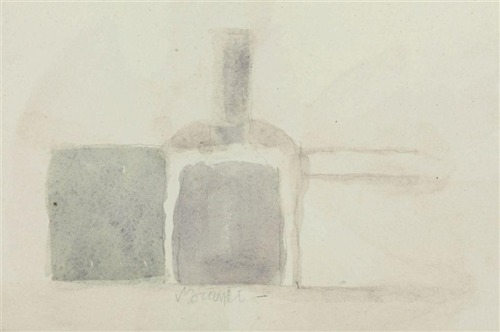


















No comments:
Post a Comment